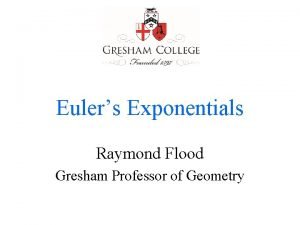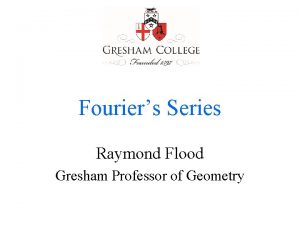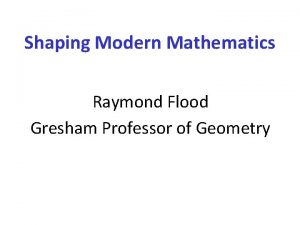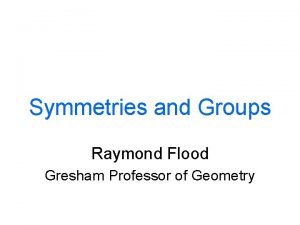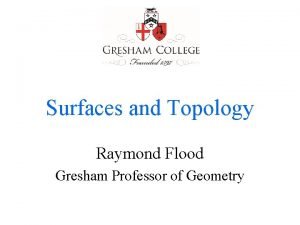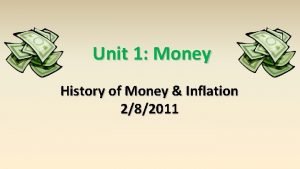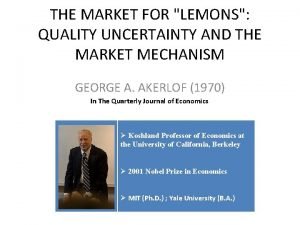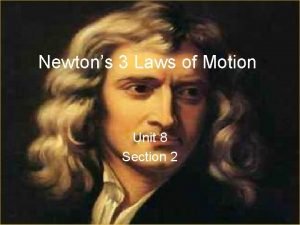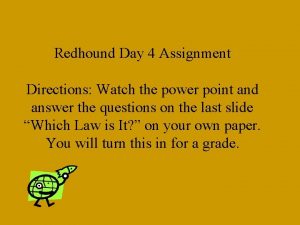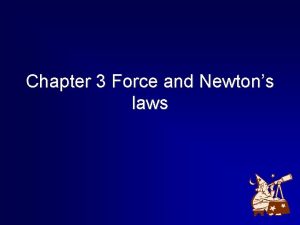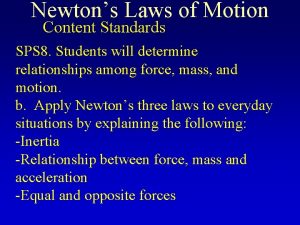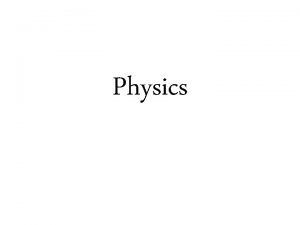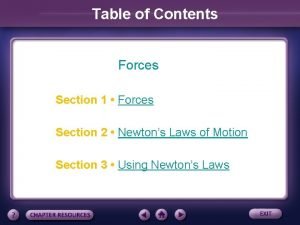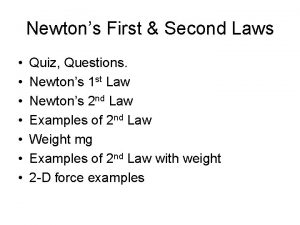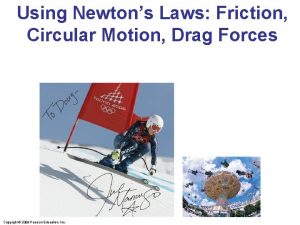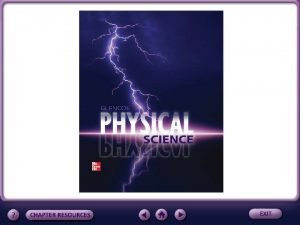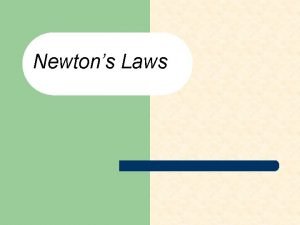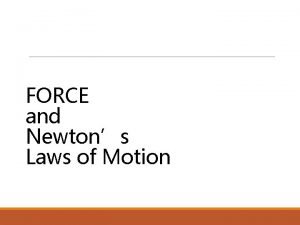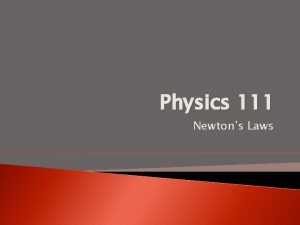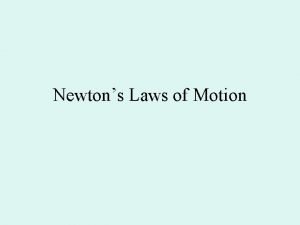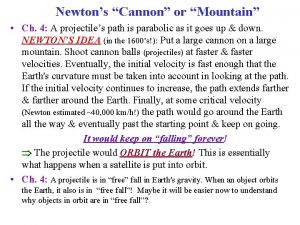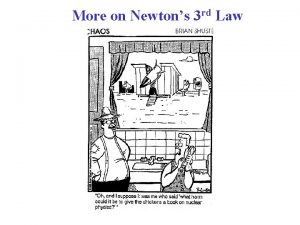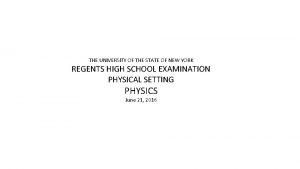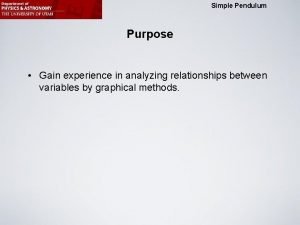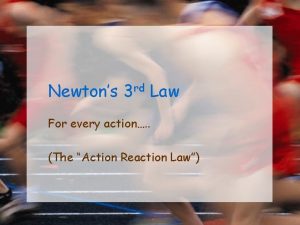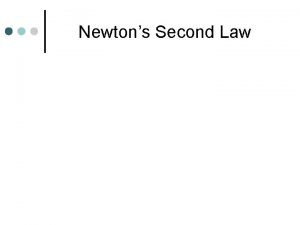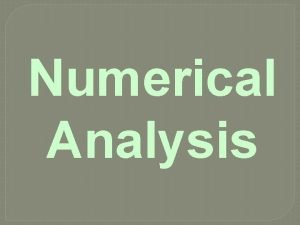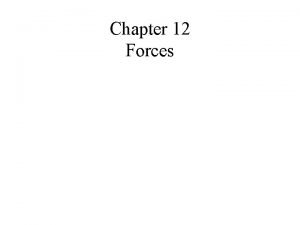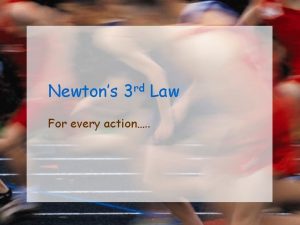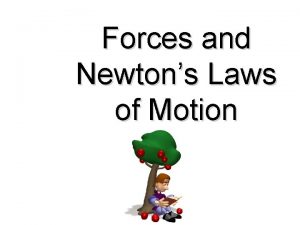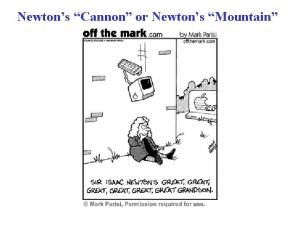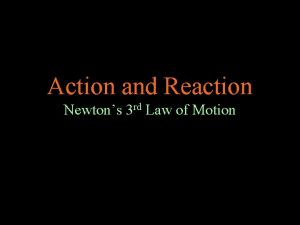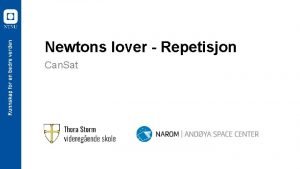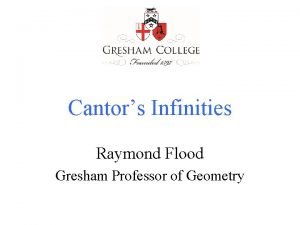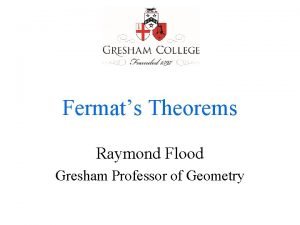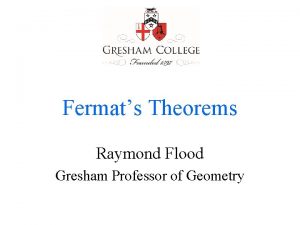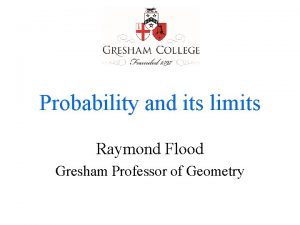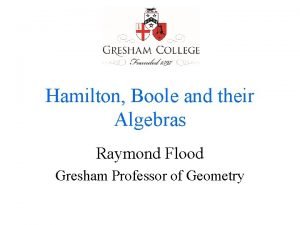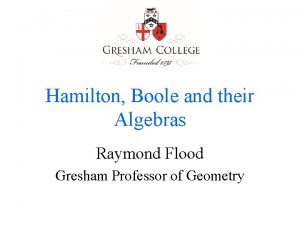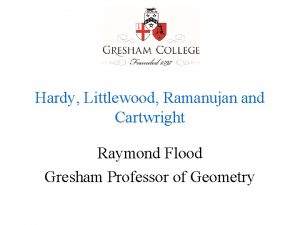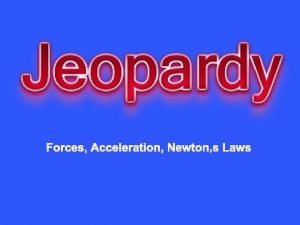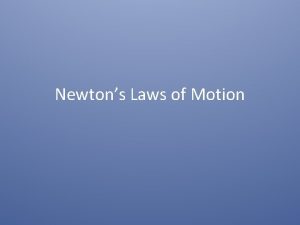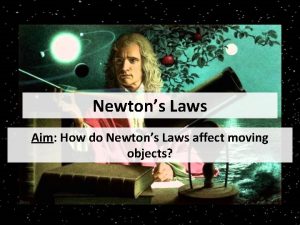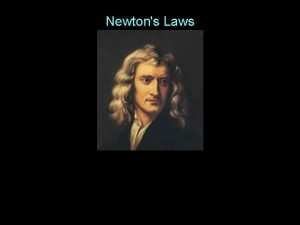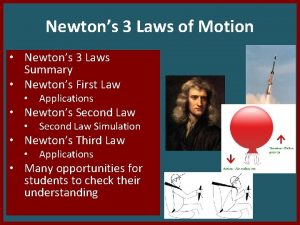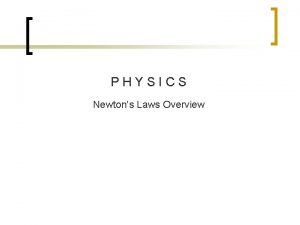Newtons Laws Raymond Flood Gresham Professor of Geometry




















![Halley visits Newton Dr [Halley] asked him what he thought the Curve would be Halley visits Newton Dr [Halley] asked him what he thought the Curve would be](https://slidetodoc.com/presentation_image_h2/b6cebd15d8bcc13141efcfe809aad1d4/image-21.jpg)































- Slides: 52

Newton’s Laws Raymond Flood Gresham Professor of Geometry

Isaac Newton 1642– 1727 Nature and Nature’s laws lay hid in Night. God said, Let Newton be! and All was light

Newton’s memorial in Westminster Abbey

Newton’s Memorial Inscription Here is buried Isaac Newton, Knight, who by a strength of mind almost divine, and mathematical principles peculiarly his own, explored the course and figures of the planets, the paths of comets, the tides of the sea, the dissimilarities in rays of light, and, what no other scholar has previously imagined, the properties of the colours thus produced. Diligent, sagacious and faithful, in his expositions of nature, antiquity and the holy Scriptures, he vindicated by his philosophy the majesty of God mighty and good, and expressed the simplicity of the Gospel in his manners. Mortals rejoice that there has existed such and so

Boys on the front of the sarcophagus

Memorial above the Sarcophagus

Date Age 1642 Event Birth of Isaac Newton 1655 12 Attends Grantham Grammar School 1661 18 Goes up to Trinity College, Cambridge 1665 22 Jan: Graduates Bachelor of Arts at Cambridge Aug: Moves back to Lincolnshire because of the plague 1667 24 Return to Cambridge, elected Fellow of Trinity 1669 26 Elected Lucasian Professor of Mathematics 1672 29 Elected Fellow of the Royal Society 1684 41 Halley’s visit leads to preparation of Principia 1687 44 Publication of Principia 1689 46 Member of Parliament for Cambridge University 1693 50 Mental breakdown 1696 53 Moves to London as Warden of the Mint 1700 57 Master of the Mint 1703 60 Elected President of the Royal Society 1704 61 Publication of Opticks 1705 62 Knighted by Queen Anne 1727 84 Death of Isaac Newton

Date Age 1642 1655 Event Birth of Isaac Newton 12 Attends Grantham Grammar School Woolsthorpe Manor, near Grantham. Lincolnshire— the birthplace of Isaac Newton. The Free Grammar School of King Edward VI, Grantham, where Newton was a pupil.

Date Age 1642 Event Birth of Isaac Newton 1655 12 Attends Grantham Grammar School 1661 18 Goes up to Trinity College, Cambridge 1665 22 Jan: Graduates Bachelor of Arts at Cambridge Aug: Moves back to Lincolnshire because of the plague 1667 24 Return to Cambridge, elected Fellow of Trinity 1669 26 Elected Lucasian Professor of Mathematics 1672 29 Elected Fellow of the Royal Society 1684 41 Halley’s visit leads to preparation of Principia 1687 44 Publication of Principia 1689 46 Member of Parliament for Cambridge University 1693 50 Mental breakdown 1696 53 Moves to London as Warden of the Mint 1700 57 Master of the Mint 1703 60 Elected President of the Royal Society 1704 61 Publication of Opticks 1705 62 Knighted by Queen Anne 1727 84 Death of Isaac Newton

Date Age 1642 Event Birth of Isaac Newton 1655 12 Attends Grantham Grammar School 1661 18 Goes up to Trinity College, Cambridge 1665 22 Jan: Graduates Bachelor of Arts at Cambridge Aug: Moves back to Lincolnshire because of the plague Trinity College, Cambridge in about 1690

Date Age 1642 Event Birth of Isaac Newton 1655 12 Attends Grantham Grammar School 1661 18 Goes up to Trinity College, Cambridge 1665 22 Jan: Graduates Bachelor of Arts at Cambridge Aug: Moves back to Lincolnshire because of the plague 1667 24 Return to Cambridge, elected Fellow of Trinity 1669 26 Elected Lucasian Professor of Mathematics 1672 29 Elected Fellow of the Royal Society 1684 41 Halley’s visit leads to preparation of Principia 1687 44 Publication of Principia 1689 46 Member of Parliament for Cambridge University 1693 50 Mental breakdown 1696 53 Moves to London as Warden of the Mint 1700 57 Master of the Mint 1703 60 Elected President of the Royal Society 1704 61 Publication of Opticks 1705 62 Knighted by Queen Anne 1727 84 Death of Isaac Newton

Plague Years In the beginning of the year 1665 I found the Method of approximating series & the Rule for reducing any dignity of any Binomial into such a series. The same year in May I found the method of Tangents of Gregory and Slusius, & in November had the direct method of fluxions & the next year in January had the Theory of Colours & in May following I had entrance into ye inverse method of fluxions.

Plague Years And the same year I began to think of gravity extending to ye orb of the Moon &. . . I deduced that the forces wch keep the Planets in their Orbs must [be] reciprocally as the squares of their distances from the centres about wch they revolve: & thereby compared the force requisite to keep the Moon in her Orb with the force of gravity at the surface of the earth, & found them answer pretty nearly.

Plague Years All this was in the two plague years of 1665 — 1666. For in those days I was in the prime of my age for invention & minded Mathematicks & Philosophy more than at any time since.

Analysis by infinite series Manuscript page, 1665

Close up of manuscript page

Date Age 1642 Event Birth of Isaac Newton 1655 12 Attends Grantham Grammar School 1661 18 Goes up to Trinity College, Cambridge 1665 22 Jan: Graduates Bachelor of Arts at Cambridge Aug: Moves back to Lincolnshire because of the plague 1667 24 Return to Cambridge, elected Fellow of Trinity 1669 26 Elected Lucasian Professor of Mathematics 1672 29 Elected Fellow of the Royal Society 1684 41 Halley’s visit leads to preparation of Principia 1687 44 Publication of Principia 1689 46 Member of Parliament for Cambridge University 1693 50 Mental breakdown 1696 53 Moves to London as Warden of the Mint 1700 57 Master of the Mint 1703 60 Elected President of the Royal Society 1704 61 Publication of Opticks 1705 62 Knighted by Queen Anne 1727 84 Death of Isaac Newton

1667 24 Return to Cambridge, elected Fellow of Trinity 1669 26 Elected Lucasian Professor of Mathematics 1672 29 Elected Fellow of the Royal Society 1684 41 Halley’s visit leads to preparation of Principia 1687 44 Publication of Principia 1689 46 Member of Parliament for Cambridge University 1693 50 Mental breakdown

Date Age 1642 Event Birth of Isaac Newton 1655 12 Attends Grantham Grammar School 1661 18 Goes up to Trinity College, Cambridge 1665 22 Jan: Graduates Bachelor of Arts at Cambridge Aug: Moves back to Lincolnshire because of the plague 1667 24 Return to Cambridge, elected Fellow of Trinity 1669 26 Elected Lucasian Professor of Mathematics 1672 29 Elected Fellow of the Royal Society 1684 41 Halley’s visit leads to preparation of Principia 1687 44 Publication of Principia 1689 46 Member of Parliament for Cambridge University 1693 50 Mental breakdown 1696 53 Moves to London as Warden of the Mint 1700 57 Master of the Mint 1703 60 Elected President of the Royal Society 1704 61 Publication of Opticks 1705 62 Knighted by Queen Anne 1727 84 Death of Isaac Newton

1696 53 Moves to London as Warden of the Mint 1700 57 Master of the Mint 1703 60 Elected President of the Royal Society 1704 61 Publication of Opticks 1705 62 Knighted by Queen Anne 1727 84 Death of Isaac Newton The Tower of London (where the Mint was situated), 1707. When Newton became Warden of the Mint, he lived at first in the tower.
![Halley visits Newton Dr Halley asked him what he thought the Curve would be Halley visits Newton Dr [Halley] asked him what he thought the Curve would be](https://slidetodoc.com/presentation_image_h2/b6cebd15d8bcc13141efcfe809aad1d4/image-21.jpg)
Halley visits Newton Dr [Halley] asked him what he thought the Curve would be that would be described by the Planets supposing the force of attraction towards the Sun to be reciprocal to the square of their distance from it. Sr Isaac replied immediately that it would be an Ellipsis, the Doctor struck with joy & amazement asked him how he knew it, why saith he I have calculated it, whereupon Dr Halley asked him for his calculation without any farther delay, Sr Isaac looked among his papers but could not find it, but he promised him to renew it, & then to send it him.


Newton’s Three laws of Motion 1. Every Body perseveres in its state of rest or of moving uniformly straight forward, except insofar as it is compelled to change its state by forces impressed. 2. A change in motion is proportional to the motive force impressed and takes place along the straight line in which that force is impressed. 3. To any action there is always an opposite and equal reaction.

Newton’s cradle


Law of Universal Gravitation The gravitational attraction between two masses varies directly as the product of the masses and inversely as the square of the distance separating them.

A Treatise of the System of the World, 1728 Available on Goggle books: http: //tinyurl. com/ngl 2 ow 6

From Newton’s A Treatise of the System of the World, 1728

Equal areas in equal times – Kepler’s second law This states that the line joining a planet to the Sun sweeps out equal areas in equal times – essentially this is a way of quantifying the idea that planets move faster when near the Sun and slower when at the extremities of their orbits.

Book 1 Proposition 1 Theorem 1 The areas, which revolving bodies describe by radii drawn to an immovable centre of force do lie in the same immovable planes, and are proportional to the times in which they are described.

Equal areas in equal times

Equal areas in equal times

Equal areas in equal times

Equal areas in equal times

Equal areas in equal times

Equal areas in equal times

Prove: area SAB = area SBC

area SAB = area SBc and area SBC = area SBc so area SAB = area SBC

area SAB = area SBc

area SBC = area SBc

area SAB = area SBc and area SBC = area SBc so area SAB = area SBC

area SAB = area SBc and area SBC = area SBc so area SAB = area SBC

Inverse square law Problem: Given the shape of the orbit, an ellipse, and the fixed centre towards which the force responsible for the shape of that orbit points, how does the magnitude of that force vary with the distance of that force from the centre? Answer: The force must obey an inverse square law.

Is the Solar System Stable? Given a system of arbitrarily many mass points that attract each according to Newton’s law, under the assumption that no two points ever collide, try to find a representation of the coordinates of each point as a series in a variable that is some known function of time and for all of whose values the series converges uniformly King Oscar II, his son Gustav, grandson Gustav-Adolf and great-grandson Prince Gustav-Adolf

Henri Poincaré 1854 -1912

Qualitative behaviour of solutions • Solution is a path in a multidimensional space – phase space Henri Poincaré 1854 -1912

Phase space and Poincaré section Amended from Encyclopaedia Britannica, 1999

Qualitative behaviour of solutions • Solution is a path in a multidimensional space – phase space • Poincaré section • Periodic tells us system is stable • Quasiperiodic • Chaotic Henri Poincaré 1854 -1912

• Simulated evolution of the solar system over 5 Gyr • 2501 different scenarios • Slight change in the starting conditions e. g. move Mercury by 1 metre • one per cent of the solutions lead to a large increase in Mercury’s eccentricity—an increase large enough to allow collisions with Venus or the Sun. • in one of these high-eccentricity solutions, a subsequent decrease in Mercury’s eccentricity induces a transfer of angular momentum from the giant planets that destabilizes all the terrestrial planets about 3. 34 Gyr from now, with possible collisions of Mercury, Mars or Venus with the Earth

So is the solar system stable? See Chapter 8 Orbital Chaos Three-body Problem

So is the solar system stable? Probably not! But we won’t be around to find out. See Chapter 8 Orbital Chaos Three-body Problem

1 pm on Tuesdays Museum of London Fermat’s Theorems: Tuesday 16 September 2014 Newton’s Laws: Tuesday 21 October 2014 Euler’s Exponentials: Tuesday 18 November 2014 Fourier’s Series: Tuesday 20 January 2015 Möbius and his Band: Tuesday 17 February 2015 Cantor’s Infinities: Tuesday 17 March 2015
 Gresham professor of geometry
Gresham professor of geometry Gresham professor of geometry
Gresham professor of geometry Quickest descent
Quickest descent Raymond flood
Raymond flood Hexagonal torus
Hexagonal torus Gresham's law
Gresham's law Greahams law
Greahams law Colin skateboards down the sidewalk
Colin skateboards down the sidewalk What are newtons laws
What are newtons laws What are the laws of motion
What are the laws of motion Newton three law
Newton three law Section 3 using newtons law
Section 3 using newtons law Examples of law of inertia
Examples of law of inertia What are newton's 3 laws
What are newton's 3 laws Cause of motion
Cause of motion Universal gravitation law
Universal gravitation law Newton laws
Newton laws Section 1 forces
Section 1 forces Newton's three law
Newton's three law Newton's first and second law quiz
Newton's first and second law quiz Law of friction
Law of friction Newton's 3 laws
Newton's 3 laws Newtons 3 laws
Newtons 3 laws Elevator bank
Elevator bank Newtons laws
Newtons laws Newtons laws definitions
Newtons laws definitions Newtons laws
Newtons laws Newtons laws of gravity
Newtons laws of gravity Newtons third law
Newtons third law First law of motion facts
First law of motion facts Promotion from associate professor to professor
Promotion from associate professor to professor Useless laws weaken the necessary laws
Useless laws weaken the necessary laws 4 electron domains 2 lone pairs
4 electron domains 2 lone pairs The basis of the vsepr model of molecular bonding is
The basis of the vsepr model of molecular bonding is Lewis structure for pf3
Lewis structure for pf3 Newtons mountain
Newtons mountain Newtons 3 rd law of motion
Newtons 3 rd law of motion Newtons 2 nd law
Newtons 2 nd law Newtons 3 rd law example
Newtons 3 rd law example A box weighing 46 newtons
A box weighing 46 newtons Newtons second laq
Newtons second laq Vad betyder motkraft
Vad betyder motkraft Newtons 3 rd law
Newtons 3 rd law Example of law of motion
Example of law of motion Definition of interpolation in numerical analysis
Definition of interpolation in numerical analysis Newton's second law
Newton's second law Newton's third law
Newton's third law Newtons 3 rd law
Newtons 3 rd law Newton’s law of action-reaction
Newton’s law of action-reaction Newtons first law pictures
Newtons first law pictures Newtons mountain
Newtons mountain Newtons 3 rd law of motion
Newtons 3 rd law of motion Newton gravity 10
Newton gravity 10
